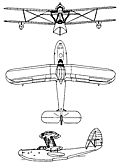|
| The Aichi E11A1 night reconnaissance flying boat, known to the Allies under the codename Laura, first flew in prototype form in June 1937. Competing against the Kawanishi E11K1, it proved to have superior performance, and was ordered into production as the Navy Type 98 Night Reconnaissance Seaplane.
Of biplane configuration, the two-step hull carried a braced tail unit, with the tail-plane and elevator mounted almost halfway up the fin. Accommodation was provided for a crew of three, and there was an open bow position that could be used during on-water manoeuvres, such as making fast to a buoy, as well as mounting a defensive machine gun. To enhance stability on the water, balancer floats were mounted beneath each lower wing, close to the wingtip. Power-plant consisted of a Hiro Type 91 Model 22 inline engine, mounted at the centre-section of the upper wing, and driving a pusher propeller with spinner.
Production of E11A1s totalled only 17 aircraft, and these saw limited use in their intended role in the early stages of the Pacific war.

| MODEL | E11A1 |
| CREW | 3 |
| ENGINE | 1 x Hiro type 91 mod. 22, 465kW |
| WEIGHTS |
| Take-off weight | 3300 kg | 7275 lb |
| DIMENSIONS |
| Wingspan | 14.49 m | 48 ft 6 in |
| Length | 10.71 m | 35 ft 2 in |
| PERFORMANCE |
| Max. speed | 217 km/h | 135 mph |
| Ceiling | 4400 m | 14450 ft |
| Range | 1945 km | 1209 miles |
| ARMAMENT | 1 x 7.7mm machine-gun |
 | A three-view drawing (752 x 1029) |
| Christopher C Tew, e-mail, 19.11.2021 22:03 Nice old 1 /72 plastic kit by Fujimi C-11 /72062 if you can find it. My decals look good 30+ years on. Interior detail is slight - seats, control column, instrument panel and bulkheads are it - but the instrument panel has a good decal. The clear frame includes a thick but transparent canopy, some ports, and parts for a frame to hold the upper wing in place during assembly. There is also a small frame to hold the completed model upright once finished. The hinomaru have separate white and red parts, and there are tail markings for three airplanes, but the instructions in my kit are all in Japanese, so I suppose they refer to the ships the aircraft were assigned to. The only wiring diagram is the box art. This is a goodly fractions of the 17 that were built. With its minimal defensive capability and crawlingly low top speed, it took only a short while to remove these from their intended role of night recon and gun spotting for ships at sea. reply |
| Ian Williams, e-mail, 16.11.2013 12:52 Did any plane survive the war. It would be a fine plane to have in a museum. reply | | Nigel Brearley, e-mail, 08.01.2011 18:35 Parshall, J. and Tully, A. (2005) note that the light cruiser Nagara carried a E11A1 while leading the screening destroyers for the main carrier force at Midway (p.108 also note 55 p. 545) noting that 'other Japanese sources' note that E11A1s were used on light cruiser Destroyer Division leaders at this early stage in the war. reply | | Terry Dransfield, e-mail, 20.05.2009 13:25 This aircraft looks to be a more advanced, but similar, design to the British Supermarine Walrus. Did the E11A1 have wheels and are drawings (with cross sections) available.
Thank you reply |
|
| | Terry Dransfield, e-mail, 20.05.2009 13:25 This aircraft looks to be a more advanced, but similar, design to the British Supermarine Walrus. Did the E11A1 have wheels and are drawings (with cross sections) available.
Thank you reply |
|
Do you have any comments?
|
| 
COMPANY
PROFILE
All the World's Rotorcraft
|








 Terry Dransfield
Terry Dransfield
Just doing one of these. I agree that the clear plastic in the kit is thick but it did respond well to being internally sanded thinner with 400-3000 grade pads followed by polishing with Tamiya polishing compounds. Visibility is improved to the point where I can see the seatbelts I added through the glass but not well enough to mean it was worth putting anymore than basic buckle detail onto them.
Overall - agreed - nice kit for its age though I had a 'right game' with the wing struts as I had to redo all the joints having dropped a knife on the top wing - cost me about 10 hours!
reply